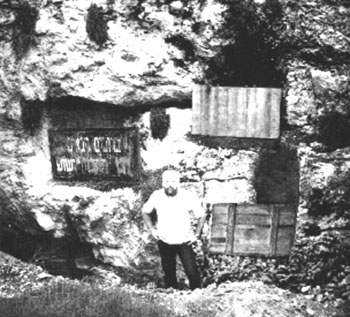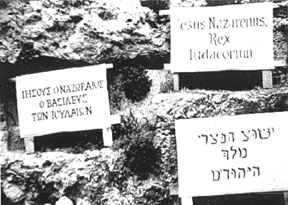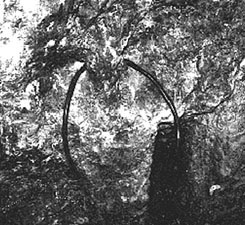|
The ARK OF THE
COVENANT continued...
But another element was also involved. In order to be a
deterrent, the CRIME of the victim had to be posted in clear sight of the
passers-by. For this purpose, they used a titilus, which was a board covered
with gypsum, inscribed with black letters. This was usually carried ahead of the
victim on the way to the crucifixion, and then posted above the cross in clear
sight. The common conception about YAHUSHUA'S crucifixion was that a single sign
written by Pilate was nailed to His cross above His head.
This may very well have been, However, in order for the
passers-by to be able to read these signs, written in three different languages,
they would have had to have been quite large, much larger than a hand-written
notice on a paper. Just recently we learned a great deal about the visibility of
signs at our new museum. We put up signs that looked very large to us (six- and
eight-inch letters) but when we placed them on our building and walked across
the street, or even to the end of the parking lot, we discovered that they were
very difficult to read. A sign written by Pilate on a piece of paper, nailed to
a cross, would have been almost impossible to read even by those standing
directly in front of the cross. Add to this the fact that in Jerusalem, three
different languages were common (Hebrew, Greek and Latin) and it becomes
apparent that the signs above YAHUSHUA'S head were much larger than we have
commonly believed.
 "YAHUSHUA of Nazareth the King of the Jews" "YAHUSHUA of Nazareth the King of the Jews"
When Ron read and reread the accounts of these signs at
YAHUSHUA'S crucifixion, he discovered that although they had been translated to
read "ON the cross, "the Greek could just as accurately have been
translated "above the cross" or "over the cross."
"And they crucified him,... 36 And sitting down
they watched him there; 37 And set up over his head his accusation written,
THIS IS YAHUSHUA THE KING OF THE JEWS." MAT 27:35
"And he bearing his cross went forth into a place
called the place of a skull, which is called in the Hebrew Golgotha: Where
they crucified him, and two other with him, on either side one, and YAHUSHUA in
the midst. And Pilate wrote a title, and put it on the cross. And the writing
was YAHUSHUA OF NAZARETH THE KING OF THE JEWS. This title then read many of the
Jews: for the place where YAHUSHUA was crucified was nigh to the city: and it was
written in Hebrew, and Greek, and Latin."JOHN 19:17-20
In the above quote from John it states that the
"title" was put "on" the cross. The Greek word here
translated to read "on" is "epi". In Luke, this following
verse also tells about the same "title", but here, the word
"epi" is translated to read "over":
"And a superscription also was written over him in
letters of Greek, and Latin, and Hebrew, THIS IS THE KING OF THE JEWS."LUKE
23:38
"Over" certainly could NOT be translated to
read "on" in this above verse! This same word, "epi," is
also translated in other places to read "above." Therefore, the
Scriptures do not specifically state that the "title" was nailed onto
the physical cross. All it states for sure is that the "title(s)" were
placed "over," "above," "about," etc., the cross.
So with this understanding, and the information on Roman crucifixions and the
titilus covered in gypsum and written in black ink that the Romans were known to
use, he felt his conclusion was at least not to be ruled out. Little did he
suspect how it would later be so incredibly confirmed.
 When he first found the niches, he placed boards in them
for demonstration purposes. Digging deeper, and showing that there were no more
niches below these, he had signs painted in the three languages which they set
up and photographed. He believed the much smaller niche was for the ever-present
Roman eagle. But again, this wasn't the purpose of this excavation so they
continued to dig. When he first found the niches, he placed boards in them
for demonstration purposes. Digging deeper, and showing that there were no more
niches below these, he had signs painted in the three languages which they set
up and photographed. He believed the much smaller niche was for the ever-present
Roman eagle. But again, this wasn't the purpose of this excavation so they
continued to dig.
In Danger of Collapse
As they continued to dig straight down, the cliff face
was on one side, forming a solid wall. But on the other side, the earth wall
began to exhibit signs of instability and Ron feared that it would soon
collapse, perhaps burying them in the hole. He decided that they should move
back along the cliff-face to the original site that he had pointed to. He
dreaded it because of the huge boulder he had found just under the surface - but
he felt he had no choice.
Back to the Original Site
Ron had felt justified in beginning the excavation
several yards from the original site, because it was in the same general area.
And with the discovery of the niches, he was satisfied that it hadn't been a
completely wasted effort - but still he had another purpose for this excavation.
As they began to dig around the huge boulder extending
out from the original site, he discovered that there was enough room behind it
(between it and the cliff-face) to begin their dig. As they began to dig
downward, they very soon came upon another item of interest. Carved out of the
cliff-face was a hole which extended through a section of protruding rock
allowing a rope or similar object to be threaded through it. The great care
obviously devoted to chiseling out this object indicated that it had an
important use, but they would learn that later.
 The first site they had begun excavating was where the
cliff-face was relatively vertical like a wall. Here, the cliff-face slanted
inward, forming a "roof" over the place they were digging. As they dug
down into the earth, they found open areas beneath the surface which contained a
large amount of pottery shards, and even a few pieces still intact. The first site they had begun excavating was where the
cliff-face was relatively vertical like a wall. Here, the cliff-face slanted
inward, forming a "roof" over the place they were digging. As they dug
down into the earth, they found open areas beneath the surface which contained a
large amount of pottery shards, and even a few pieces still intact.
A Grain Storage Bin later Used as a Cistern
They reached bedrock 38 feet below the present ground
surface. Carefully removing debris, they found themselves in an approximately 15
foot diameter round chamber carved out of the rock with steps chiseled into the
shaft descending from the top in a spiral to the bottom.
At some point in time it had been modified and
plastered, reused as a cistern. Either of these explanations would explain the
presence of the "rope hole" chiseled in the cliff-face -- it was for
the rope that held the bucket or jug which was lowered down into the shaft to
retrieve grain or water. Ron chiseled through the plaster and found a large
amount of pottery among the dirt and debris used as fill to form the cistern.
Continue reading about
the Ark of the Covenant...
|




 When he first found the niches, he placed boards in them
for demonstration purposes. Digging deeper, and showing that there were no more
niches below these, he had signs painted in the three languages which they set
up and photographed. He believed the much smaller niche was for the ever-present
Roman eagle. But again, this wasn't the purpose of this excavation so they
continued to dig.
When he first found the niches, he placed boards in them
for demonstration purposes. Digging deeper, and showing that there were no more
niches below these, he had signs painted in the three languages which they set
up and photographed. He believed the much smaller niche was for the ever-present
Roman eagle. But again, this wasn't the purpose of this excavation so they
continued to dig. The first site they had begun excavating was where the
cliff-face was relatively vertical like a wall. Here, the cliff-face slanted
inward, forming a "roof" over the place they were digging. As they dug
down into the earth, they found open areas beneath the surface which contained a
large amount of pottery shards, and even a few pieces still intact.
The first site they had begun excavating was where the
cliff-face was relatively vertical like a wall. Here, the cliff-face slanted
inward, forming a "roof" over the place they were digging. As they dug
down into the earth, they found open areas beneath the surface which contained a
large amount of pottery shards, and even a few pieces still intact.